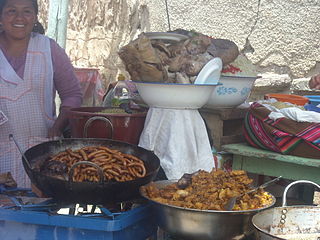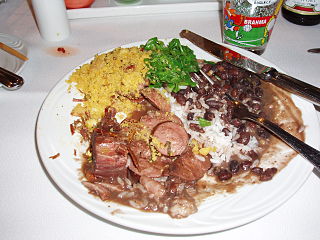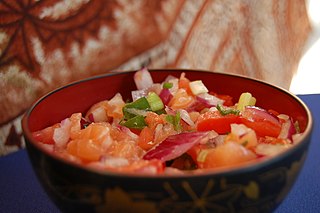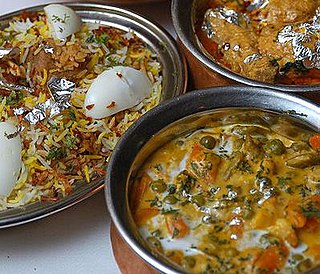
American Chinese cuisine is a style of Chinese cuisine developed by Americans of Chinese descent. The dishes served in many North American Chinese restaurants are adapted to American tastes and often differ significantly from those found in China.

American cuisine reflects the history of the United States, blending the culinary contributions of various groups of people from around the world, including indigenous American Indians, African Americans, Asians, Europeans, Pacific Islanders, and South Americans. Early Native Americans utilized a number of cooking methods in early American cuisine that have been blended with early European cooking methods to form the basis of what is now American cuisine. The European settlement of the Americas introduced a number of ingredients, spices, herbs, and cooking styles to the continent. The various styles of cuisine continued expanding well into the 19th and 20th centuries, proportional to the influx of immigrants from many different nations; this influx nurtured a rich diversity in food preparation throughout the country.

Fusion cuisine is cuisine that combines elements of different culinary traditions. Cuisines of this type are not categorized according to any one particular cuisine style and have played a part in innovations of many contemporary restaurant cuisines since the 1970s.

South American cuisine has many influences, due to the ethnic fusion of South America. The most characteristic are Native American, African, Spanish, Italian, Portuguese, and Indian-South Asian. However, there is a mix of European, North American, and indigenous cuisines. The customs and food products greatly vary according to the physically distinct regions.

Indonesian cuisine consists of the various regional cuisines in parts of Indonesia; there are a wide variety of recipes and cuisines in part because Indonesia is composed of approximately 6,000 populated islands of the total 17,508 in the world's largest archipelago, with more than 300 ethnic groups calling Indonesia home. Many regional cuisines exist, often based upon indigenous culture with some foreign influences. Indonesia has around 5,350 traditional recipes, with 30 of them considered the most important. Indonesia's cuisine may include rice, noodle and soup dishes in modest local eateries to street-side snacks and top-dollar plates.

Latin American cuisine is the typical foods, beverages, and cooking styles common to many of the countries and cultures in Latin America. Latin America is a highly diverse area of land that holds various cuisines that vary from nation to nation. Some items typical of Latin American cuisine include maize-based dishes arepas, pupusas, tacos, tamales, tortillas and various salsas and other condiments. These spices are generally what give the Latin American cuisines a distinct flavor; yet, each country of Latin America tends to use a different spice and those that share spices tend to use them at different quantities. Thus, this leads for a variety across the land. Sofrito, a culinary term that originally referred to a specific combination of sautéed or braised aromatics, exists in Latin American cuisine. It refers to a sauce of tomatoes, roasted bell peppers, garlic, onions and herbs.

Lomi salmon is a side dish in Hawaiian cuisine. It is a fresh tomato and salmon salad, and was introduced to Hawaiians by early Western sailors. It is typically prepared by mixing salted, shredded salmon with tomatoes, sweet gentle Maui onions, and occasionally scallions, and sometimes crushed ice if it is not refrigerated. It is always served cold.

New Zealand cuisine is largely driven by local ingredients and seasonal variations. An island nation with a primarily agricultural economy, New Zealand yields produce from land and sea. Similar to the cuisine of Australia, the cuisine of New Zealand is a diverse British-based cuisine, with Mediterranean and Pacific Rim influences as the country becomes more cosmopolitan.

Chinese Indonesian cuisine is characterized by the mixture of Chinese with local Indonesian style. Chinese Indonesians brought their legacy of Chinese cuisine, and modified some of the dishes with the addition of Indonesian ingredients, such as kecap manis, palm sugar, peanut sauce, chili, santan and local spices to form a hybrid Chinese-Indonesian cuisine. Some of the dishes and cakes share the same style as in Malaysia and Singapore which are known as the Nonya cuisine by the Peranakan.

Regional cuisine is cuisine based upon national, state or local regions. Regional cuisines may vary based upon food availability and trade, varying climates, cooking traditions and practices, and cultural differences. One noteworthy definition is based upon traditional cuisine: "A traditional cuisine is a coherent tradition of food preparation that rises from the daily lives and kitchens of a people over an extended period in a specific region of a country, or a specific country, and which, when localized, has notable distinctions from the cuisine of the country as a whole." Regional food preparation traditions, customs and ingredients often combine to create dishes unique to a particular region. Regional cuisines are often named after the geographic areas or regions that they originate from.

Alaea salt, sometimes referred to as Hawaiian red salt, is an unrefined sea salt that has been mixed with an iron oxide rich volcanic clay called 'alaea', which gives the seasoning its characteristic brick red color. It is part of Native Hawaiian cuisine and is used in traditional dishes such as kalua pig, poke, and pipikaula. It was also traditionally used to cleanse, purify and bless tools, canoes, homes and temples. Once exported to the Pacific Northwest to cure salmon, it saw a resurgence in popularity late in the 20th century in fusion style cuisine of Hawaii both on Islands and beyond.










